The Camino de Santiago Part 3: Crossing the Meseta
…continued from Part 2: Navarra
I return to the cathedral and continue west out of the city. Following the riverwalk along a nice grove of trees, Burgos is awfully quiet. This is because it’s the end of the Semana Santa, the Spanish Holy Week and today is Easter Sunday. At 10am everybody is inside the churches attending Mass. And though I could count the number of locals on the street right now, I would find out later that the main plaza will eventually be packed wall to wall with people.
Going out of the city, the path winds uneventfully west along the highway for the rest of the day. Neither I, nor my gear, feels broken in – something that I lost by splitting this trip into sections. Having landed from a redeye flight into Madrid early this morning, my body thinks I stayed up all night as I hike into the afternoon, drowsy and exhausted. I expect my hiking schedule will force me out of my jetlag sooner than later, but right now I would rather lay on the grass than cross another bridge or pass another marker. I check in at the little town of Rabé de las Calzadas, where the only lady in the building stamps my Pilgrim’s Passport, the first of many to come.


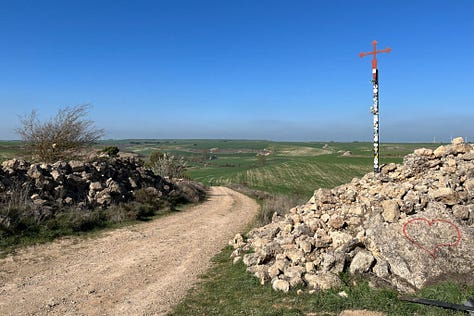




Going west, the terrain crosses numerous hills and plateaus in the following days, with huge open vistas and often little protection from the erratic weather patterns that I should have expected in Mid-April. Clouds and scattered showers roll across the countryside as I approach the town of Castrojeriz on the fifth day. It is situated on the side of a large hill with a castillo at the top.
I have time to kill that afternoon and leave my pack at the aubergue to scuffle up to the summit. The overlook across the valley is spectacular, revealing the quilted terrain of farms spanning out across the plains and rolling hills far into the distance. Wind is fierce, blasting me in the face each time I look out from the castle walls, but I don’t care.




Hiking on, the chilly wind continues over more exposed ridges under grey skies. People try to ignore it and take selfies on the windy face of each dramatic hilltop overlook. Eventually these hills will level into the flat plain of the central Meseta, where I plan to hike for about a week.
Others are out here too. Though we almost never hike at the same speed, I start to recognize more people whenever I stop at a café or hostel. So far, I have met Karen the funny Belgian, and two Germans, one of whom looks like an older Johnny Knoxville. We sit together in the evenings, exhausted, eating pilgrim dinners with some hearty combination of meat, potatoes, wine, and pastries. Karen especially makes me laugh, often being the kind of person who makes others laugh at their own jokes.
For the most part, the weather is okay during my first week. Well, nothing great in life comes easy. And for every great high point in life that I achieve, there must be a time when my circumstances amount to an absolute, unmitigated pile of shit. Out here, it manifests in the form of what appears on the radar to be the remnants of a huge tropical depression poised to cover the entire Iberian Peninsula. It’s going to start tomorrow and continue for an undetermined number of days.
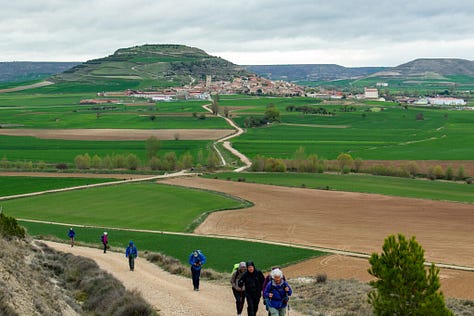





With no practical choice but to continue on, I leave the little town of Carrión de los Condes in the morning in my rain gear. The first few hours are bearable as clouds and scattered showers roll across the path, and are easily ignored. Continuing into the Meseta’s flat open farm country, hills and mountains farther off are obstructed by the fog and rainstorms. One in particular is closing in from the south like the arm of a giant beast. This dark wall of rain looks like it will get here in about 20 minutes. It hits us sooner.
With nothing protecting me as I hike on a straight road through the open countryside, the rainstorm pummels me with lateral gusts of wind and hard, cold rain pelting me in the face. Hours go by as I push myself through the monsoon, rushing water, and puddles on the dirt road. I look down and see shards of sleet on my jacket.
I hate to stop, but I have to go around a bush to pee. I struggle, shivering, to get my fleece gloves off of my numb fingers, and for a second I wonder if my own dick is frozen.
This goes on for ten miles. With no respite. Finally, I descend a hill and see a café at the edge of a small town. It’s crowded with pilgrims trying to get out of the rain. Everyone has a blank look of shock on their faces, like they’re trying to process what the fuck just happened. I find Karen and the Germans and try to warm up with a café con leche.
After two more hours of the same, I finally get to my aubergue. Both my Pilgrim’s Passport and my real one are soaking wet – turns out my rain cover wasn’t enough out there. So I check in, wondering if it’s still valid for border crossings – a question to eventually bring to the fucking embassy in the coming weeks.
That was my day, how was yours?


I leave the next day as the harsh winds continue from the southwest, though the rain seems to have let up slightly. It picks up again around mid-morning as I pass through Sahagún, the official halfway point of the Camino. A nice old abuela gets out of her car. She sees me and yells “Buen Camino!” making me feel encouraged as I continue on with this punishment.
I forget that the Camino forks into northern and southern routes and I lose a couple hours by hiking on the wrong one. Backtracking for hours east, south, and west straight into headwinds and scattered showers, I reach the aubergue, get dinner, and crash.
And then all is quiet. The rain system that ruined the last two days (and maybe my Passport) has moved on. And so has the wind, leaving barely a breeze behind for the next morning. I go back out on the street at sunrise and continue into the country. Sierras in the north are completely covered in snow, reminding me of Colorado.
I continue onward across the drying landscape. I’m set to reach León tomorrow and I’m making an extra five mile push reach a town aubergue in Puente Villarente just outside of the city.
I want to get to León early and rest for the day. So I leave an hour before daybreak the next morning, hiking slowly on the path under the stars. Behind me, a sharp yellow crescent moon rises above the quiet farmlands. Slowly, a red glow brightens on the eastern horizon, the stars above fade away one by one, and a new day begins.
I reach the city centre of León at mid-morning, and enjoy the rest of the day walking around the main plaza next to the cathedral. There are three of us at the aubergue – me, an older German lady, and Choi the Korean Chef. She invites the host and fixes the three of us a bibimbap dinner, with more than enough protein and rice for everybody. It’s a welcome break from all the great serrano ham and queso bocadillos I’ve been eating since I got here. As it is with this Camino, the dinners often become an exchange of cultures, cuisines, experiences, and the shared ethos of goodwill. Because while we each walk this path for ourselves, we also share a part of whatever this is with each other.
I go out to get something from the supermarket. As I’m walking by a tavern at the main plaza, Kirstie from Scotland waves at me and yells my name. She’s at a table with twenty other people and points to an empty seat. They’re all pilgrims. And they have been drinking here for five hours. What I think started as a small group turned into a party as more and more familiar faces found the table.



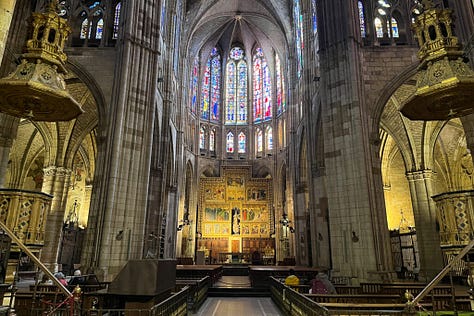


There is wine. There is food. There is each of us – all pilgrims celebrating together that we have gotten this far. To the backdrop of the huge cathedral just across the plaza.
“Do ye know tha Space Ghouls?” Kirstie asks me.
“Huh?”
“I said do ye know the Spice Girls?” This is her test to see if people can get past her thick Glasgow accent. I didn’t pass.
Kara the Canadian sat across the table. She ended her Camino at the halfway point a few days ago after some foot problems. The rainstorm was her breaking point. She intends to come back. There was Caleb the loud Irishman, Nick the Brit, the Israeli who reminds me of Borat, and so many others, carrying on into the evening. I decide after a few hours that this is great but I should get going. I have a big day tomorrow and I don’t want to ruin it with too much wine.
Speaking of wine, I had ordered about five or six glasses over the evening and then asked the server to bring me my check. For the quality and quantity, I would easily be paying at least $80 at any wine bar in Chicago. He brings the ticket back and I look at it. 6 Euros.
It’s a full day hike from León to Hospital de Órbigo. The clouds are back, threatening to ruin my day again with more rain showers. By mile 15, my feet are beyond sore and hurting with each step – not enough to warrant anything serious like an evacuation, but enough to get into my head and distract me from this lovely fucking countryside. To make it worse, the bottom of my left foot gets spasms if I hike on it for too long when I’m out of shape, causing my toes to clench together. This has already happened a couple of times out here when I hiked farther than my body wanted me to. Well, sometimes my body needs to listen to me. So I keep going.
After what was an hour of pain and felt like longer, I reach the iconic Puente de Órbigo, a long bridge of many arches crossing a river into the town. I’m exhausted, but not so much that I don’t appreciate such an impressive medieval landmark. Even if the cobblestones are hard on my miserable feet. I check into an albergue in town just as soon as another downpour starts.

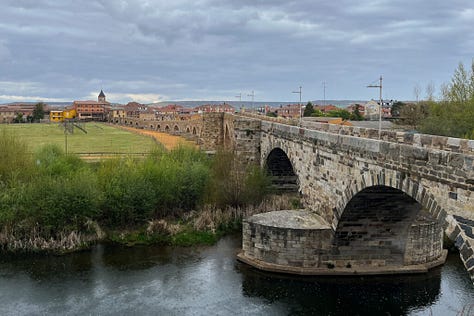
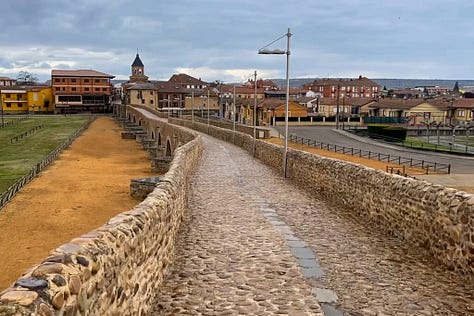

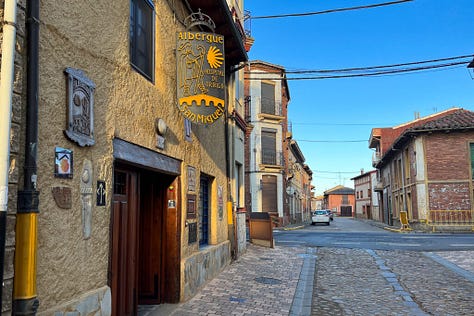




It’s day 24. And a perfect bluebird morning. I start out at sunrise and make my way past the little town of Villares and the edge of the plains. As I hike into the hills, I look back one last time at the vast plains of the Meseta, green and hazy in the sunlight of the morning.
Two hours later, I reach a cross on a hilltop looking over Astorga, a city like so many others noted by its centuries-old winding streets, vibrant plazas, and magnificent cathedrals. Beyond the city is the backdrop of the western mountains, slowly changing in colors under looming springtime clouds. Somewhere out there, the Way to Santiago continues on a hard gravel road, beaten down each day by the feet of a thousand pilgrims. It still feels like a lifetime away – and it will until the day when it’s suddenly not – but I’m energized and hopeful as I descend the hillside and make my way into town.
This story continues on The Way to Santiago.


